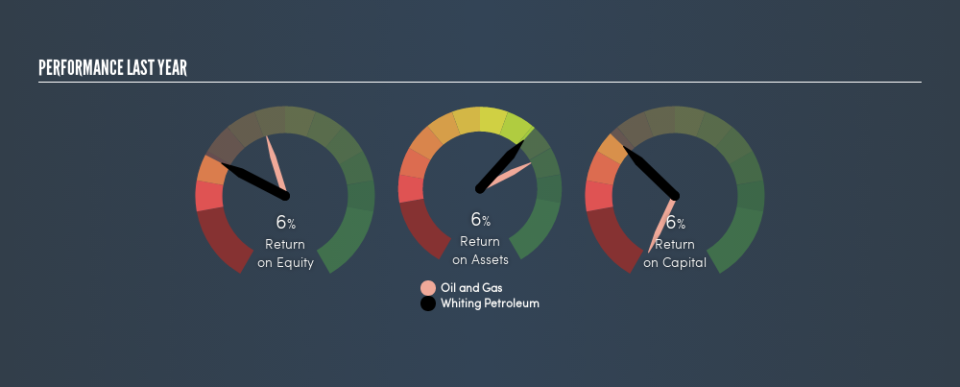Why You Should Care About Whiting Petroleum Corporation’s (NYSE:WLL) Low Return On Capital

Today we are going to look at Whiting Petroleum Corporation (NYSE:WLL) to see whether it might be an attractive investment prospect. Specifically, we'll consider its Return On Capital Employed (ROCE), since that will give us an insight into how efficiently the business can generate profits from the capital it requires.
Firstly, we'll go over how we calculate ROCE. Second, we'll look at its ROCE compared to similar companies. Finally, we'll look at how its current liabilities affect its ROCE.
What is Return On Capital Employed (ROCE)?
ROCE is a metric for evaluating how much pre-tax income (in percentage terms) a company earns on the capital invested in its business. All else being equal, a better business will have a higher ROCE. In brief, it is a useful tool, but it is not without drawbacks. Author Edwin Whiting says to be careful when comparing the ROCE of different businesses, since 'No two businesses are exactly alike.'
So, How Do We Calculate ROCE?
The formula for calculating the return on capital employed is:
Return on Capital Employed = Earnings Before Interest and Tax (EBIT) ÷ (Total Assets - Current Liabilities)
Or for Whiting Petroleum:
0.065 = US$433m ÷ (US$7.8b - US$1.1b) (Based on the trailing twelve months to June 2019.)
So, Whiting Petroleum has an ROCE of 6.5%.
See our latest analysis for Whiting Petroleum
Does Whiting Petroleum Have A Good ROCE?
When making comparisons between similar businesses, investors may find ROCE useful. We can see Whiting Petroleum's ROCE is meaningfully below the Oil and Gas industry average of 8.3%. This performance is not ideal, as it suggests the company may not be deploying its capital as effectively as some competitors. Setting aside the industry comparison for now, Whiting Petroleum's ROCE is mediocre in absolute terms, considering the risk of investing in stocks versus the safety of a bank account. Investors may wish to consider higher-performing investments.
Whiting Petroleum reported an ROCE of 6.5% -- better than 3 years ago, when the company didn't make a profit. That suggests the business has returned to profitability. You can click on the image below to see (in greater detail) how Whiting Petroleum's past growth compares to other companies.
When considering this metric, keep in mind that it is backwards looking, and not necessarily predictive. ROCE can be misleading for companies in cyclical industries, with returns looking impressive during the boom times, but very weak during the busts. ROCE is only a point-in-time measure. We note Whiting Petroleum could be considered a cyclical business. Since the future is so important for investors, you should check out our free report on analyst forecasts for Whiting Petroleum.
Whiting Petroleum's Current Liabilities And Their Impact On Its ROCE
Short term (or current) liabilities, are things like supplier invoices, overdrafts, or tax bills that need to be paid within 12 months. Due to the way the ROCE equation works, having large bills due in the near term can make it look as though a company has less capital employed, and thus a higher ROCE than usual. To check the impact of this, we calculate if a company has high current liabilities relative to its total assets.
Whiting Petroleum has total assets of US$7.8b and current liabilities of US$1.1b. As a result, its current liabilities are equal to approximately 14% of its total assets. This very reasonable level of current liabilities would not boost the ROCE by much.
Our Take On Whiting Petroleum's ROCE
If Whiting Petroleum continues to earn an uninspiring ROCE, there may be better places to invest. Of course, you might also be able to find a better stock than Whiting Petroleum. So you may wish to see this free collection of other companies that have grown earnings strongly.
If you are like me, then you will not want to miss this free list of growing companies that insiders are buying.
We aim to bring you long-term focused research analysis driven by fundamental data. Note that our analysis may not factor in the latest price-sensitive company announcements or qualitative material.
If you spot an error that warrants correction, please contact the editor at editorial-team@simplywallst.com. This article by Simply Wall St is general in nature. It does not constitute a recommendation to buy or sell any stock, and does not take account of your objectives, or your financial situation. Simply Wall St has no position in the stocks mentioned. Thank you for reading.

 Yahoo Finance
Yahoo Finance 
